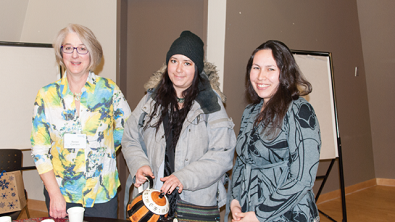Renee Carriere (left) and 2 students from Cumberland House Charlebois School. Photo courtesy Saskatchewan Teachers Federation publication.
A research project undertaken by students at Cumberland House has turned into a basis for policy by the Saskatchewan Ministry of Environment to allow more burning along traplines in the area.
Students at Charlebois Community started an outdoor education science project to see why there was increased sediment in the river water, and ended up looking into how spring burning around the lakes regenerates vegetation.
Teacher Renee Carriere says they discovered post-burn plant growth directly contributed to a robust muskrat population, but changes to provincial environment policies over the years limited burning around lakes and traplines.
For example, Carriere says there were over 750,000 muskrats in the area 60 years ago, whereas last year she and her husband trapped 323 muskrats.
In December of 2016, the government changed policy to allow more burning in traplines in the area. According to Carriere, the acceptance of the findings by the Ministry of Environment legitimizes and validates the students’ use of Aboriginal knowledge in the sciences.
Carriere says the students were able to interview trappers and understand what different plant varieties are and how beneficial they were to the muskrat.
“They get to understand the biology of it and can use that information as they become hydrologists and geologists. Not everyone will be a trapper in 20 years,” she said.
Carriere added that the project made science “relevant and real” to students.
Carriere says permits are now being given out for a six-year period for burning along the lakes and traplines.
Not only did the project end up changing policy, Carriere said it also inspired her students to spend as much time outside as possible.
